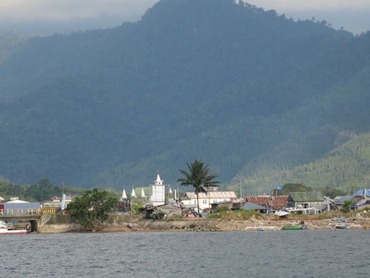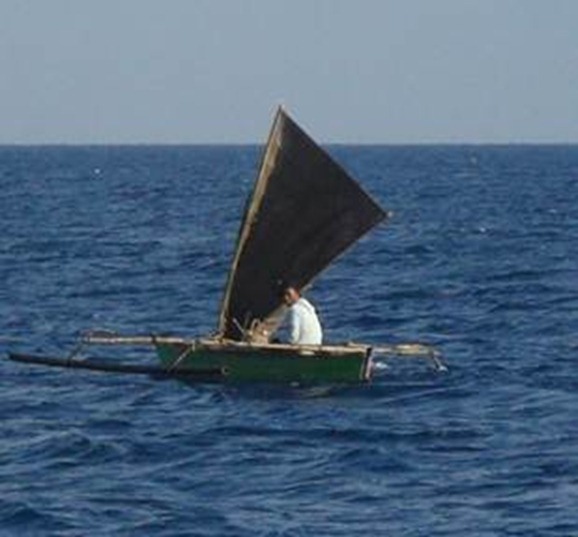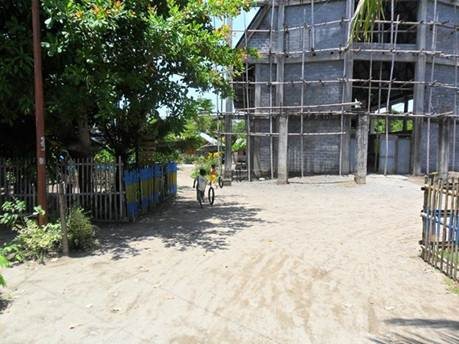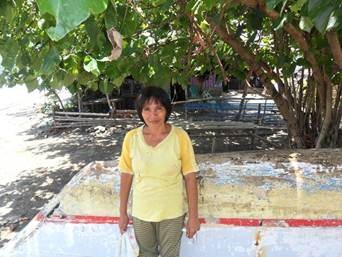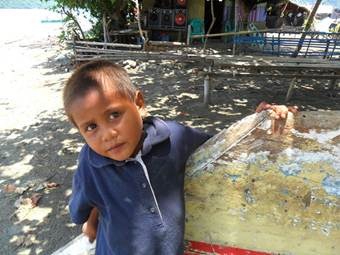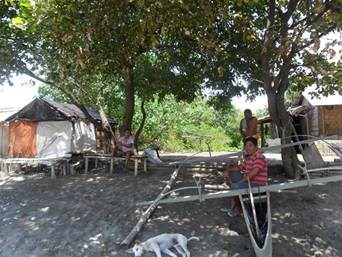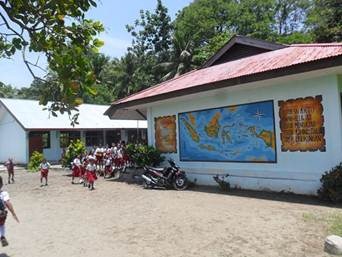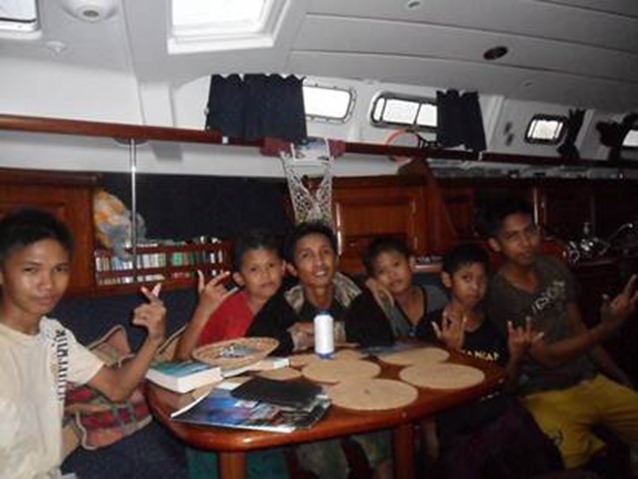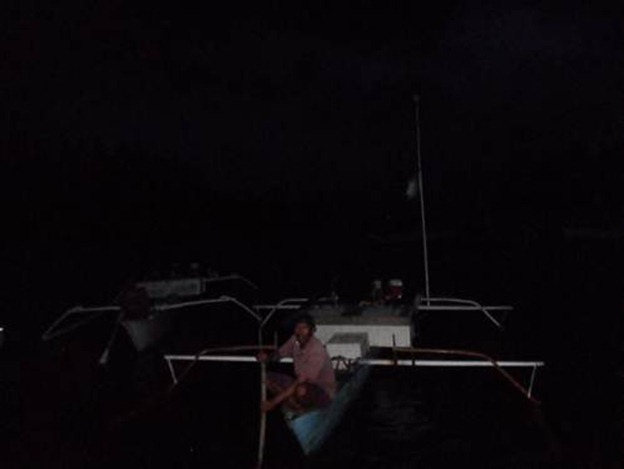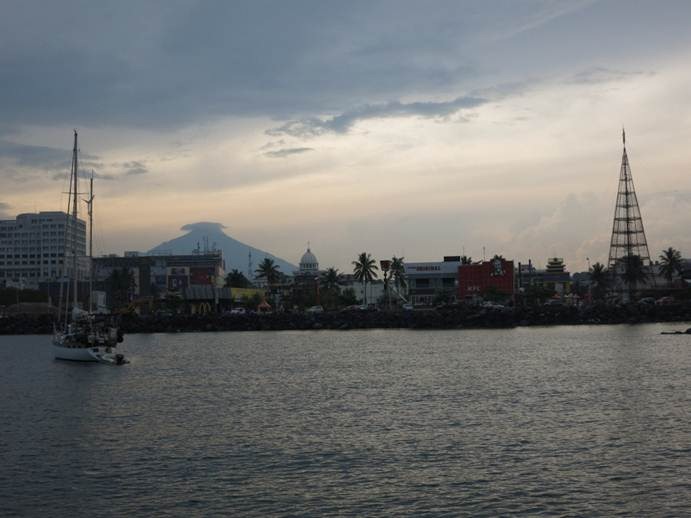North Coast of Sulawesi N01 09 24 E124 49 96

|
Tolitoli to Manado This coastline is beautiful with a mountainous backdrop flowing down to deep wide bays surrounded by mangroves, coconut palms and hillsides draped in clove trees. Volcanoes brood in the background, most extinct but some still steaming either high over the land or straight out of the sea. The spicy forest is interrupted with occasional spans of horticultural land where the fruit and vegetables are grown. In the early morning and late evening mist gathers like puffs of cloud on the hillside and clings to the dark green vegetation. Silence reigns in the bays unless there is a town or large village nearby with a mosque from where the call to prayer echoes at dusk and dawn. 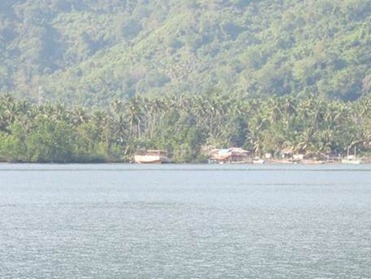 Where the sea rolls in the shoreline is laced with white sand beaches from which the local fishermen in their traditional outrigger canoes ply their trade. Many of these boats still use sails on a simple lateen rig that can be easily dropped. They are then propelled either by paddle or by simple motors hung off one side with a “longtail” that is lowered into the water as needed.
Christian Minahasans are the dominant group here with splendid churches and although there is no call to prayer, the singing rings out when the congregations are together.
One village we went to had an old Pentecostal church and a new one under construction with its bamboo scaffolding, their hallelujahs were wonderful. We went shopping here for onions and also found leeks then Shulie and her little boy Iman showed us around. The local fisher folk and the school. Our passing brought lessons to a standstill so teachers let the children out to meet us. The locals are very curious and are keen to see how we live on board. Here are a bunch of boys wide eyed at the luxuries we take for granted. They are Riski 17 (far right), Hendra 18 (far left) , Amir 24 (centre) with brothers Asri 12 and Dirjan 13 either side of him and Dimas 12 (second right). They just sat and we communicated as best we could but these boys were from islands where Indo Bahasa is not their first language so it was difficult. Riski spoke some English and acted as their spokesman and we got by with signs and laughter.
A highlight for us was when we anchored in a small anchorage behind some small islands which clearly had not been visited much before. At dusk 7 local boats returning from a day’s fishing clustered around the boat to examine what they could see. Their boats were outrigger canoes but beautifully kept with natty paint jobs including one with a Union Jack on its stern. They were well fitted out for fishing with everything to hand, including an ice box for the catch. One of them gave us a nice barracuda and in return we gave him a bag of goodies including packs of coffee and biscuits.
The guys examined our fishing gear and where intrigued by some recent home-made lures (which haven’t caught anything yet); one chap had a play with the giant wind-in reel we use. Then it was our turn, we asked what lures they used and were delighted to see they were as Heath Robinson as some of ours. They make their lures from defunct plastic buckets by cutting a rough fish shape and bending it with heat so that it gyrates through the water like a swimming fish, two substantial hooks are wired in underneath and they come home with a good catch every day. We have now bought a new bucket as one of our old ones had split so bucket fashioned lures will soon be on the agenda. The standard of living along this coast seems quite reasonable with income from apparently healthy seas and fertile hillsides. In the north east of Sulawesi coffee is grown as a cash crop together with the various spices. There is a history of wealth from spices and the influence of Dutch occupation is still here, Christianity is one of the legacies but language also. The Minahasa people were amongst the first to speak Dutch and did well as a result by getting good jobs within the Dutch administration, as a result Dutch is still valued by present day descendants. Some wealthier families speak Dutch at home and sometimes send their children off for secondary and higher education in the Netherlands. Manado the capital of Minahassa province is a large prosperous town. A view from the anchorage shows how modern life is changing the culture ….and the diet (note the prominent KFC and less obvious MacDs)! The town is perfect for re-stocking with 3 large supermarkets and a Megamall close to the anchorage supplying such luxuries as cheese, butter and booze.
There is also a local Mr Fix-it, Lucky, who can arrange fuel, tours etc. However, the anchorage is awful with deep water right until close in so that one has to anchor in 20 metres of water but within 30 metres of a very unforgiving rock sea defence. There is no protection from the north, so a big swell rolls in from time to time and sends the yachts rocking like mad things. Mostly this seems to coincide with trying to load fuel or new supplies from the dinghy or when trying to cook or sleep. At least the holding seemed good. We would have liked to stay longer and seen more of the town and the local countryside but after 2 days we had had enough and our pile of salty clothes was mounting up so we left and went 20 miles up the coast to Telok Korakora, a deep bay surrounded by mangrove and reef. This seemed perfect. We relaxed just a little sleepy then at dusk the biggest thunderstorm we have witnessed in a very long time decided to target us, the lightning was forking down onto the near banks and soon we were rocking and rolling in the swell generated by the wind. The wind didn’t last too long but long enough to lift the dinghy off the foredeck and throw it in the water… …fortunately still tied on! So we had another disturbed night as the sea swelled, the rain teemed down in bucket load with thunder and lightning banging all around us. Gone by morning but it will take the seas a while to flatten out. We’re off now with a wonderful 2.5 knots of tide pushing us along; it doesn’t feel like it but we’re whizzing along at 8 knots, fantastic! |
